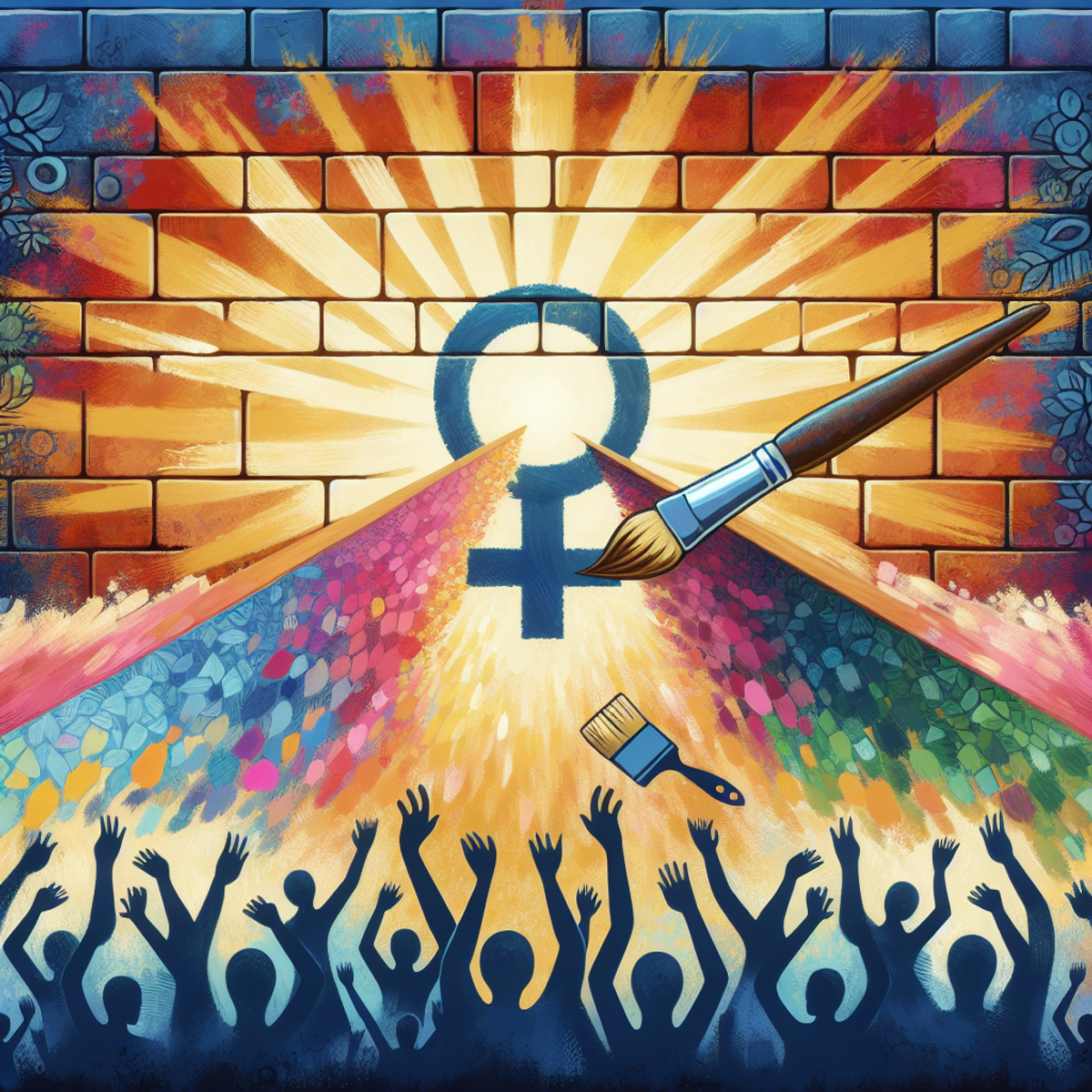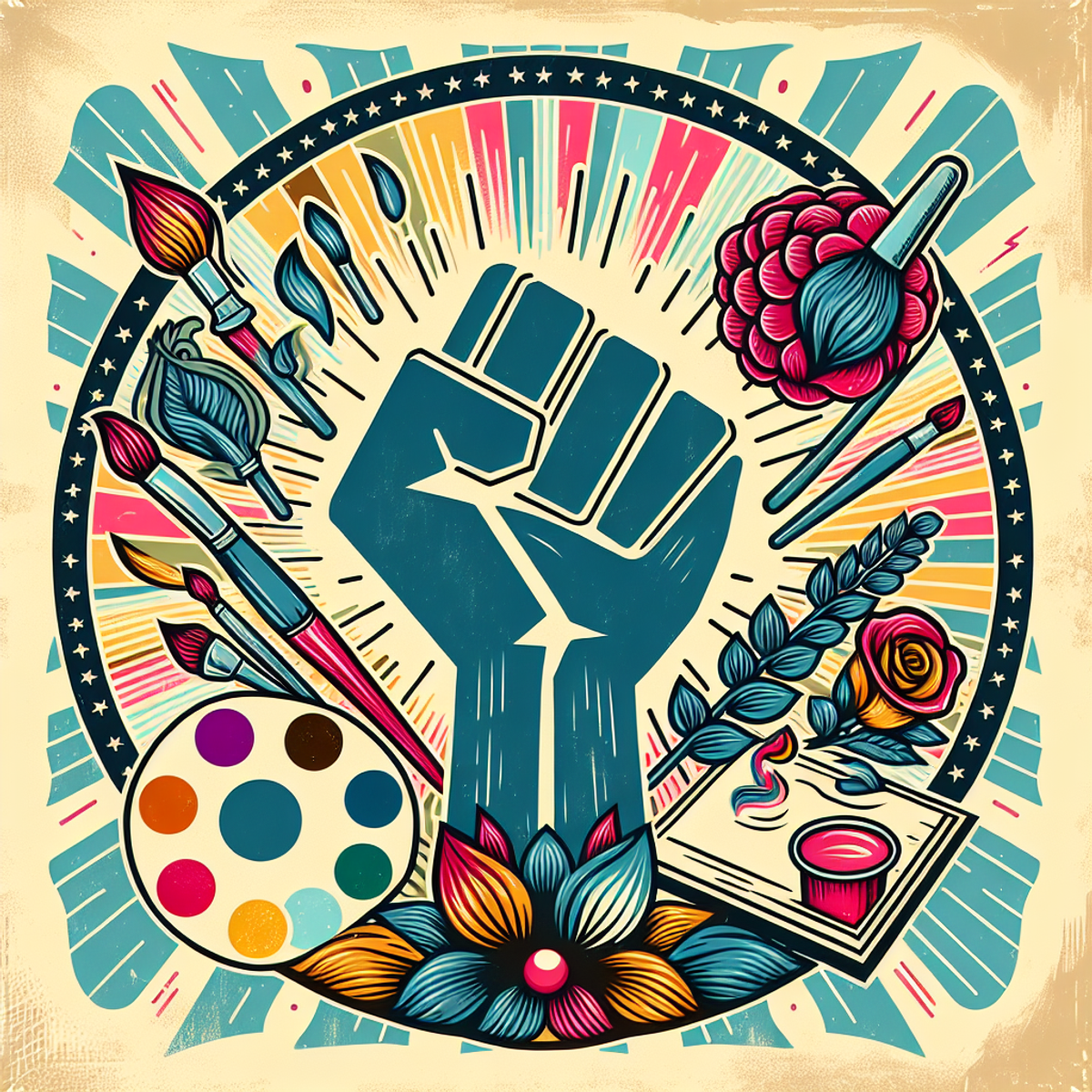1. The Emergence of Feminist Art and Its Social Significance
The feminist art movement started in the late 1960s and 1970s as a response to the social concerns of feminism. It aimed to challenge the male-dominated art world and society as a whole, working towards recognition, equality, and liberation for women artists.
Brief history of the feminist art movement in the late 1960s and 1970s
The feminist art movement came about because of the second wave of feminism that happened in the United States during this time. Women artists began to question their place within the art world and wanted to challenge the patriarchal structures that had controlled it for so long.
Challenging the male-dominated art world
Feminist artists wanted to interrupt the usual way of doing things by questioning assumptions about gender, representation, and power dynamics within the art industry. They pushed against traditional ideas of what counted as “art” and pushed for a more inclusive understanding of creativity.
Addressing social and political issues
The growth of feminist art was driven by a desire to talk about urgent social and political issues. Feminist artists used their work as a way of expressing their experiences, raising awareness about gender inequality, reproductive rights, violence against women, and other important topics.
By challenging existing norms, feminist art made it possible for more women artists to be seen and acknowledged. It created new opportunities for artistic expression while advocating for social change.
2. Diverse Goals and Themes in Feminist Artworks
Feminist artists have long been driven by the goal of achieving recognition and equality within the art industry. Through their work, they aim to challenge the patriarchal structures that have historically marginalized women artists. By questioning traditional notions of art and beauty, feminist artists seek to reshape the art world and create space for diverse voices and perspectives.
Key Themes Explored in Feminist Art
In addition to their overarching goal of gender equality, feminist artists explore a wide range of themes and issues in their artworks. These themes often reflect the lived experiences of women and address the social, political, and cultural challenges they face. Some key themes explored in feminist art include:
- Body Politics: Feminist artists have used their work to challenge societal expectations placed on women’s bodies. They critique beauty standards, objectification, sexualization, and the control exerted over women’s bodies.
- Artists like Cindy Sherman and Ana Mendieta have created powerful self-portraits that examine issues of identity, representation, and the female body.
- Gender Identity: Many feminist artists explore the concept of gender identity and its fluidity. They challenge traditional binary notions of gender and highlight the diversity of gender experiences.
- Artists like Yayoi Kusama and Kehinde Wiley address these themes through their vibrant and thought-provoking artworks.
- Intersectionality: Feminist art has evolved to embrace intersectionality, recognizing that gender inequality intersects with other forms of discrimination based on race, sexuality, class, etc.
- Artists like Carrie Mae Weems and Shirin Neshat explore the complexities of identity by addressing issues related to race, ethnicity, religion, and more.
- Domesticity and Labor: Feminist artists often critique the devaluation of domestic labor traditionally associated with women.
- Through their artwork, they challenge societal expectations placed on women as caregivers and homemakers.
- Judy Chicago’s iconic installation “The Dinner Party” celebrates women’s achievements throughout history and reclaims domestic spaces as sites of artistic expression.
By exploring these diverse themes, feminist artists not only challenge existing power structures but also give voice to marginalized experiences. Their work sparks conversations, raises awareness, and fosters dialogue about the complex issues that women face in society.
Overall, feminist art aims to disrupt norms, provoke thought, and inspire change. It provides a platform for women artists to express their perspectives, critique societal constructs, and advocate for equality. Through their diverse goals and themes, feminist artists contribute to a more inclusive and empowering art world.

3. Pushing Boundaries: Innovative Mediums and Techniques in Feminist Art
The use of both traditional mediums, such as painting and sculpture, and unconventional approaches, including performance art and new media, allows feminist artists to express their perspectives in diverse ways. This flexibility in mediums and techniques enables them to push the boundaries of conventional art forms and challenge societal norms.
The Intersection of Craft and Activism in Feminist Art
Highlighting the intersection of craft and activism in feminist art through mediums like fiber art showcases how art can be used as a tool for social commentary and change. Craftivism, a combination of craft and activism, empowers artists to address political and social issues through their artwork, blurring the lines between traditional craft techniques and contemporary activism.
Redefining Fiber Art within Feminist Art
Fiber art, often associated with domestic crafts traditionally practiced by women, has been redefined within the context of feminist art. It serves as a powerful medium for feminist expression, allowing artists to explore themes of gender, identity, and societal expectations through textiles, weaving, and other fiber-based techniques.
By embracing both traditional and unorthodox mediums, feminist artists continue to expand the definition of art while advocating for social change and challenging prevailing gender stereotypes.
4. Examining Intersectionality: Inclusivity Beyond Gender in Feminist Artworks
Feminist art has evolved over the years to embrace intersectionality, recognizing that gender inequality is not experienced in isolation but intersects with other forms of identity and oppression. Artists have expanded their narratives to encompass intersecting identities such as race, queer experiences, and disability, creating artworks that highlight the unique struggles faced by individuals who exist at the intersections of multiple marginalized identities.
Race
Feminist artists have sought to address the racial disparities within feminism itself by centering the experiences of women of color in their artwork. They challenge the dominant narratives that often exclude or marginalize women of color, using their art as a platform for representation, empowerment, and advocacy. For example, artist Lorna Simpson explores issues of race and gender through her powerful photographic works that confront stereotypes and challenge societal expectations.
Queer Identity
Many feminist artists have also embraced queer experiences and perspectives in their work. They aim to challenge heteronormative ideals and create space for diverse expressions of sexuality and gender identity. Artists like Zanele Muholi use their photography to document and celebrate the lives of LGBTQ+ individuals, bringing visibility to a community that has historically been marginalized.
Disability
Feminist artists have also turned their attention to disability, examining how ableism intersects with sexism and other forms of oppression. They shed light on the experiences of disabled individuals and challenge able-bodied norms through their artwork. For instance, disabled artist Alison Lapper creates sculptures that celebrate the beauty and strength of disabled bodies while confronting societal prejudices.
By incorporating these intersecting identities into their artwork, feminist artists contribute to a more inclusive and nuanced understanding of oppression. They strive to amplify the voices of those who are often silenced or overlooked, fostering a greater sense of solidarity among diverse communities.
5. Technology as a Tool for Subversion: The Role of Digital Mediums in Contemporary Feminist Art
Feminist artists have used technology to push the boundaries of traditional art and engage audiences in new ways. They have used mediums such as video art, digital photography, and interactive installations to challenge societal norms and make their voices heard.
Video Art
Feminist artists use video art to explore complex stories and challenge how gender is usually shown. They combine performance, storytelling, and visuals to talk about identity, power, and society’s ideas about men and women. Artists like Pipilotti Rist and Eija-Liisa Ahtila have used video art to break down stereotypes and show different ways of being feminine or a woman.
Digital Photography
Digital photography is easy to use and lets feminist artists take pictures quickly. This has helped them share their experiences, tell their own stories, and change what people think is “normal” or beautiful. Through self-portraits, changing photos on a computer, and using other people’s images in their work, artists like Cindy Sherman and Zanele Muholi have taken apart stereotypes and talked about how women are shown in movies, ads, and magazines.
Interactive Installations
Interactive installations let feminist artists make experiences that people can be part of. These artworks mix technology with real places to make people think about how women are treated differently. Artists like Rafael Lozano-Hemmer and Tania Bruguera make installations where people can touch things, hear stories, or see things that change when they get close. This makes viewers think about things like fairness between men and women, having control over your own life, and what’s fair for everyone.
By using these digital mediums, feminist artists keep making big changes, getting people talking about important things, and fighting for a fairer world. Their creative use of technology goes beyond what most people think of as art and lets people who don’t always get heard speak up.
The Ongoing Relevance of Feminist Art in Addressing Societal Issues
Feminist art continues to be a powerful force in challenging societal norms and addressing pressing issues related to gender inequality. Through their artistic creations, feminist artists have been able to dismantle gender stereotypes and question the traditional roles assigned to women. They have brought attention to the struggles faced by women in various aspects of life, including the workplace, domesticity, and sexuality.
1. Discussion on the continued importance of feminist art in challenging gender stereotypes and addressing issues like violence against women
By portraying women in unconventional ways, feminist artists have shattered the idealized images of femininity perpetuated by mainstream media and popular culture. They have encouraged viewers to question societal expectations and consider alternative narratives. Through their artwork, they have sparked conversations about gender dynamics and prompted a reevaluation of deeply ingrained biases.
Feminist art has also played a crucial role in raising awareness about violence against women. Artists have used their creative platforms to shed light on issues such as domestic abuse, sexual assault, and harassment. Their artworks serve as powerful tools for advocacy, giving voice to survivors and demanding change.
2. Summary of the empowering nature of feminist art in providing a platform for marginalized voices and advocating for social change
One of the most significant aspects of feminist art is its ability to provide a platform for marginalized voices. Historically, women artists have been underrepresented and undervalued within the art world. Feminist art has challenged this inequality by amplifying the voices of women artists and creating space for their perspectives.
Through their artwork, feminist artists have sought to give visibility to those who have been marginalized based on their gender, race, sexuality, or disability. They have created inclusive narratives that embrace intersectionality and acknowledge the complex identities of individuals.
In addition to providing a platform for marginalized voices, feminist art has been instrumental in advocating for social change. It has inspired activism, encouraged dialogue, and pushed for policy reforms. By addressing issues of gender inequality, feminist artists have paved the way for a more equitable and inclusive society.
